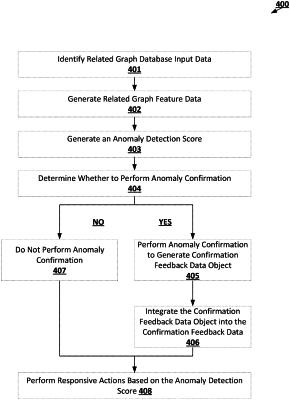| CPC G06Q 30/0185 (2013.01) [G06F 16/2379 (2019.01); G06F 16/9024 (2019.01); G06N 3/04 (2013.01); G06N 3/08 (2013.01); G06Q 40/08 (2013.01)] | 20 Claims |

|
1. A computer-implemented method comprising:
generating, based at least in part on related graph database input data, related graph feature data for a predictive entity, wherein the related graph feature data comprises a feature vector for each related graph database object of one or more related graph database objects associated with the predictive entity;
generating, based at least in part on the related graph feature data and using a graph convolutional neural network model, an anomaly detection score for the predictive entity, wherein at least a portion of the graph convolutional neural network model is trained using confirmation feedback data associated with a graph convolutional anomaly detection;
responsive to a determination to perform an anomaly confirmation with respect to the predictive entity:
performing the anomaly confirmation to generate a confirmation feedback data object for the predictive entity, and
integrating the confirmation feedback data object for the predictive entity into the confirmation feedback data associated with the graph convolutional anomaly detection; and
initiating the performance of one or more responsive actions based at least in part on the anomaly detection score.
|